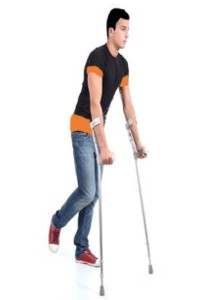 Rapid recovery programmes were first described by a Danish surgeon Henrik Kehlet in 1997 . The aim is to target factors that delay the post operative recovery following your total hip and knee replacement surgery to help an individual recover faster and safely. The rapid recovery programme is evidence based that requires a multimodal approach via a coordinated clinical pathway. A multidisciplinary approach will help achieve the best possible outcome for our patients.
Rapid recovery programmes were first described by a Danish surgeon Henrik Kehlet in 1997 . The aim is to target factors that delay the post operative recovery following your total hip and knee replacement surgery to help an individual recover faster and safely. The rapid recovery programme is evidence based that requires a multimodal approach via a coordinated clinical pathway. A multidisciplinary approach will help achieve the best possible outcome for our patients.
We know that osteoarthritis of the hip can significantly affect the quality of life. Osteoarthritis of the hip occurs less commonly in patients as young as in their 40s and more commonly in the 60 to 70 years old group. Patients with femero-acetabular impingement syndrome and hip dysplasia could get premature arthritis of the hip joint.
- Total hip replacement surgery has been shown to provide an excellent quality of life improvement.
- Over the last decade rapid recovery programmes have successfully demonstrated benefits to individuals undergoing total hip replacement surgery.
 Individuals with arthritis in their hip can enter a rapid recovery joint replacement pathway following discussion with Mr Parminder J Singh at any of his consulting locations in Melbourne, to assess their eligibility. The individual case complexity will determine if you are suitable to enter a rapid recovery programme.
Individuals with arthritis in their hip can enter a rapid recovery joint replacement pathway following discussion with Mr Parminder J Singh at any of his consulting locations in Melbourne, to assess their eligibility. The individual case complexity will determine if you are suitable to enter a rapid recovery programme.
Rapid recovery is a technique that has a number of advantages, such as:
- helps reduce the pain after surgery
- enables early mobilization
- reduces the post-operative medical complications
- reduces the length of stay in hospital
- improved pace and quality of recovery
 Rapid recovery following your hip replacement utilizes a structured approach to reduce the multiple variables associated with each individual.
Rapid recovery following your hip replacement utilizes a structured approach to reduce the multiple variables associated with each individual.
The rapid recovery programme can be divded into 3 main phases; namely the preoperative, intraoperative and post operative phases.
Pre-operatively – Prior to your hip replacement surgery, Mr Parminder J Singh will arrange for you to see a peri-operative physician. The physican will perfom a detailed medical assessment and help optimse any medical conditions you have prior to your surgery. For example if there is any pre-operative anaemia, this should be improved prior to any surgery to enhance your recovery. Likewise, if you have any diabetes, this will need to be assessed and opimised prior to your surgery to mininise any risk of post operative infection.
With respect to eating prior to your surgery, solid food is allowed 6 hours prior to your surgery. However, a more cautious approach in patients with morbid obesity and or poorly controlled diabetes may require further consideration.
 With respect to pre-operative hydration, clear fluids 2 hours prior to your surgery helps reduce dehydration . The selection of pain relief before your surgery 2 hours before combined with following your surgery is important with respect to your mobilization.
With respect to pre-operative hydration, clear fluids 2 hours prior to your surgery helps reduce dehydration . The selection of pain relief before your surgery 2 hours before combined with following your surgery is important with respect to your mobilization.
Intra-operatively – Parminder J Singh will perform a minimally invasive anterior or mini posterior approach (direct superior approach) to implant the hip replacement.
- Injection of local anesthetic into the soft tissue around the hip joint will help reduce the pain and reduce the amount of pain medication immediately after your surgery.
 Post operatively – Following your hip replacement surgery, opioid based medications can produce more side effects to your body leading to a slowing of your recovery. In particular, opiods can increase your post operative nausea and delay recovery. Reducing the number of drains such as urinary catheter can also help enhance your recovery. Trying to mobilize 4-6 hours on day 1 wearing your own clothes under the supervision of the physiotherapist is an important step to take on your journey to rapid recovery. A rapid recovery joint replacement programme will help improve the patient experience to a level where individuals feel confident and safe to return home. The rapid recovery programme is not suited for everyone; however, Mr Parminder J Singh will discuss your eligibility on a case-by-case basis. If you are interested in exploring the option of a rapid recovery joint replacement programme, you can schedule a personal consultation with Dr. Singh, at any of his consulting locations in Melbourne.
Post operatively – Following your hip replacement surgery, opioid based medications can produce more side effects to your body leading to a slowing of your recovery. In particular, opiods can increase your post operative nausea and delay recovery. Reducing the number of drains such as urinary catheter can also help enhance your recovery. Trying to mobilize 4-6 hours on day 1 wearing your own clothes under the supervision of the physiotherapist is an important step to take on your journey to rapid recovery. A rapid recovery joint replacement programme will help improve the patient experience to a level where individuals feel confident and safe to return home. The rapid recovery programme is not suited for everyone; however, Mr Parminder J Singh will discuss your eligibility on a case-by-case basis. If you are interested in exploring the option of a rapid recovery joint replacement programme, you can schedule a personal consultation with Dr. Singh, at any of his consulting locations in Melbourne.
Frequently Asked Questions About Hip Replacement?
What Is The Process Moving Forward?
Step 1: Book A Consultation
If you do require surgery, we will schedule and walk you through the process of your operation.
Step 2 Schedule Surgery
During your appointment, Dr Parminder Singh will take a history, examine you and review the relevant radiology. If any further scans are required Dr Singh will request those. Once the diagnosis has been confirmed Dr Singh will discuss the non-surgical option and surgical options of surgery. If no surgery is required Dr Singh may refer you to a physiotherapist for non-surgical management. If surgery is required Dr Singh will consent you for the surgery explained the risk and benefits of the procedure and the expected outcome.
Step 3 Surgery
Dr Parminder Singh will see you before the surgery in the waiting bay and ensure all your questions have been answered prior to surgery.
Dr Parminder Singh will examine your hip, thigh and leg making sure there are no open wounds or signs of skin infection.
If there are any signs of infection, you surgery will be cancelled and rescheduled for another day. Once this has been check Dr Parminder Singh will draw an arrow on the side of your thigh confirming with you the side of surgery. Dr Parminder Singh will check your consent form to again confirm the operation being performed and side of surgery.
Step 4 Recovery
Following your surgery, you will recover on the ward. Most individual stay three to four nights in the hospital and will be seen by the physiotherapist on the ward to facilitate mobilisation using crutches for the first 1-2 weeks.
Some individuals will use the crutches for longer depending on the type of injury and treatment required. Dr Parminder Singh will see you in his rooms approximately 10-14 days after the hip replacement surgery and inspect the hip wound.
The stitches will be removed during this appointment. Dr Parminder Singh will also explain the operative findings and recommended precautions and rehabilitation required. Another appointment will typically be organised for you around 6-8 week after this date to assess your progress. In the meantime, rehabilitation is usually recommended with a physiotherapist who has experience with hip replacement patients.
It is important to follow the hip precautions Dr Parminder Singh recommends to allow for the best possible outcome.
Further appointments will be made at approximately 6 and 12months post operatively and check x-rays will be requested. Dr Parminder Singh recommends to allow approximately 3 months for the soft tissue healing from the surgery and hip precautions during this period. The bone healing will continue for up to 12 months after surgery and Dr Singh will check this for you during the following up appointments. In terms of longer term, Dr Singh will review you in 5, 10, 15, 20 years after your hip replacement with regular x-rays.
Consulting Locations
Richmond VIC 3121
Book a consultation on:
(03) 9428 4128
Brighton VIC 3186
Book a consultation on:
(03) 9428 4128
Boxhill VIC 3128
Book a consultation on:
(03) 9428 4128
343-357 Blackburn Rd,
Mt. Waverley VIC 3149
Book a consultation on:
(03) 9428 4128
Book Online at Waverley Private Hospital
Blackburn VIC 3130
Book a consultation on:
(03) 9428 4128
Book Online at Forest Hill
Gisborne VIC 3437
Book a consultation on:
(03) 9428 4128
Book Online at Gisborne
262 Main St,
Mornington VIC 3931
Book a consultation on:
(03) 9428 4128
Book Online at Mornington
Blanton Dr,
Mulgrave VIC 3170
Book a consultation on:
(03) 9428 4128
108 Bridport Street,
Albert Park VIC 3206
Book a consultation on:
(03) 9428 4128
Book Online at Albert Park
240 Hoppers Lane,
Werribee VIC 3030
Book a consultation on:
(03) 9428 4128
Book a Consultation
Committed to improving the quality of patient advice, treatment and care in the field of orthopaedics, book a one-on-one consultation with Dr Parminder J Singh today.


